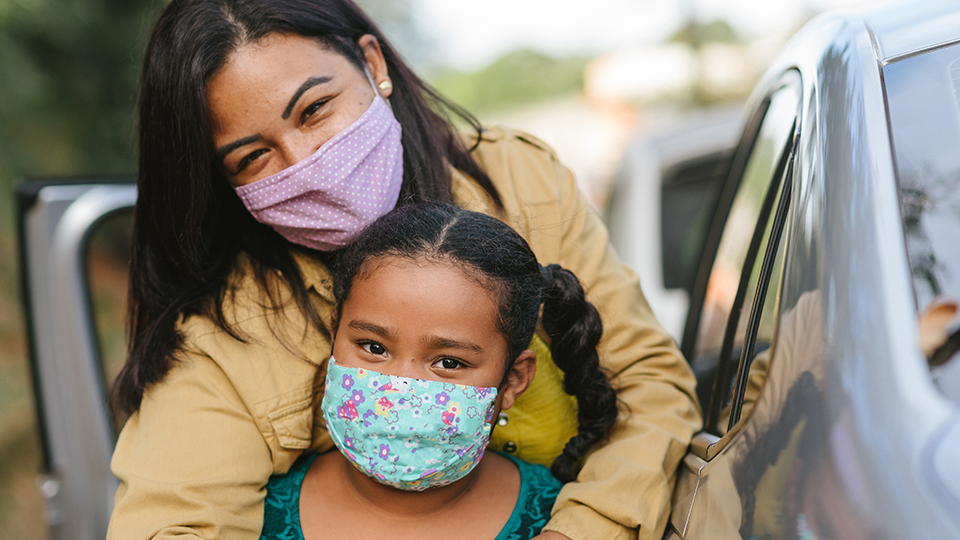Throughout the fall and winter of 2020, AAP advocacy staff and the expert panel of individuals with lived experience planned and engaged in a series of discussions, including through small groups and larger convenings with diverse multidisciplinary stakeholders from the child welfare community.[1] Throughout the project there was a strong focus on understanding the short- and long-term needs of children and families due to the pandemic and the new complexities in service delivery. There also was a strong sense of urgency to correct policies and practices that contribute to chronic racial injustices in child welfare. Thus, child welfare reform practices should be specific to the disproportionality of and disparities present in the system. Through much discussion, debate, and analysis with and among the expert panel, a set of shared values emerged that in turn inform and animate the policy recommendations.
Core Values
These core values for policy reforms were informed and designed by the perspectives of key participants with lived experience and served as a guiding map for the policy recommendations.
- Review current child welfare investigation and child removal policies to eliminate punitive practices and attitudes that contribute to over-surveillance of families of color.
- Create a culture among child welfare agencies of inclusion and respect for all families, including by involving persons with lived and living experience in agency decision making and policy development.
- Recruit and train staff and caregivers with skills and motivation necessary to nurture family bonding; affirm the racial, cultural and ethnic diversity of children and families served by child welfare; and effectively treat trauma, including secondary trauma among staff.
- Draw on and utilize research on child development and neuroscience to better understand, prevent, and treat trauma. Recognize that parents’ own trauma histories impact their parenting styles and capacities and use trauma-informed strategies to meet the needs of children and families.
- Re-examine and amend policies to ensure resources are directed to keep families safely together, nurture family bonds and prevent the need for foster care.
- Embrace a culture of innovation that utilizes technology that can spur positive results for families and enhance agencies’ performance. As seen during the pandemic, access to computers, Wi-Fi and software applications has been critical to connecting children and families to each other, school, work, court proceedings, case workers, health and mental health professionals, peer support networks and more.
Policy Recommendations Based on These Values
These proposed federal reforms are designed to support advancements in child welfare policy that promote equity, constituent engagement, and an evidence-based focus on outcomes for children and families.
1. Build on the important prevention and family-strengthening goals of the Family First Prevention Services Act to further incentivize agencies to implement prevention programs and reduce child welfare involvement.
The AAP championed Family First because this bipartisan law offers a major opportunity to shift the animating principles that drive child welfare financing. Rather than continuing to pay for the highest-cost settings with the poorest outcomes, Family First emphasizes family placement when foster care is necessary and high-quality residential treatment only when a child’s needs cannot be met within a family for a period of time. Critically, the law uses federal financing to question the very need for foster care in many cases by opening up unlimited federal matching dollars to support services to address some of the unmet needs that frequently drive child welfare involvement, including mental health and substance use disorder treatment and in-home parenting skills-supports. While further upstream prevention services outside of child protective services involvement are necessary to further address the systemic racism and bias that often drives families’ involvement in the child welfare system, we believe these reforms will strengthen Family First in ways that support that overall shift.
Actions to address this goal should include:
- Build upon the promise of Family First through additional service categories and significant investment in primary prevention services that enable families to avoid child welfare involvement. Major and long-term investments in primary prevention services, including access to cash assistance and concrete resources, through service lines outside the traditional child protective services system, would ensure that families can access needed concrete supports rather than facing the prospect of unnecessary investigation and a child needlessly entering foster care. Congress should build upon Family First by ensuring these prevention resources also address issues that are core drivers of child welfare involvement, including behavioral health services access, housing instability, and domestic violence.
- Support for families struggling with substance use disorder is crucial as the pandemic stretches on along with isolation and loneliness. Additionally, the pandemic has resulted in a negative impact to families by the limited access to treatment. Ensuring families have timely access to substance use treatments is necessary to ensure families can thrive and prevent children from entering foster care.
- Additionally, more funding is necessary to hire, train, and adequately compensate child welfare professionals to ensure they are able to effectively serve children and families’ needs while reducing secondary trauma and preventing burnout.
- Extend the timeframe during which Family First state matching requirements are waived to encourage agencies to design and deliver critically important prevention services. Family First originally required states to cover half of the cost of prevention services. Congress has waived state matching requirements through September of 2021 to address state budget shortfalls during the pandemic. Vulnerable families across the country are experiencing added strain due to the pandemic and state budgets will take a long time to recover. Congress should fully federally fund Family First until the devastating COVID-19 pandemic and it’s devastating economic and social consequences have abated to incentivize agencies to leverage the FFPSA option and then provide a higher baseline reimbursement to promotes health and safety at a critical time, and ultimately reduce the long-term state matching component so that states prioritize this vital program.
- Increase programmatic flexibility to agencies by (1) extending the “effective date” of the requirement that at least 50 percent of a state’s reimbursement for its FFPSA prevention program is for “well supported “programs, (2) expanding the scope of services eligible for federal reimbursement to include time-limited cash assistance to help low-income families meet concrete needs and minimize poverty-related neglect cases; (3) allowing states to demonstrate on population-based interventions, including multi-sector efforts as well as interventions led by non-child welfare agencies and private sector partners.
- Lift up the importance of children and families with lived experience having meaningful opportunities to participate in decision making about policies and programs by requiring state child welfare agencies to establish advisory boards of persons with lived experience with the system to serve as ongoing advisors to FFPSA prevention plan development, revision, and implementation. Their lived experience as alumni of foster care, birth parents, kinship caregivers, or foster parents will offer unique perspectives and help ensure state plans align with the services families need. Advisory board members should be compensated, and the composition of advisory boards should reflect the racial, ethnic and cultural diversity of families served by the child welfare agency. A majority of the advisory board members should annually approve the state’s prevention plan. We also encourage using this approach for other child welfare policy beyond Family First.
2. Improve policies and practices relating to reporting and investigating child maltreatment.
Current child welfare policies systemically treat poverty as neglect, which leads to traumatic unnecessary removals from families without addressing the underlying unmet needs that negatively affect child and family health. The majority of families that come to the attention of child welfare do so as a result of neglect rather than abuse. In fact, the most recent Child Maltreatment report indicates that out of all of the children investigated for maltreatment, nearly 61% were determined to be cases of neglect. Frequently, cases of neglect are related to poverty or unmet parental needs around access to treatment of mental health and substance use disorders. Systemic racism and implicit bias play key roles in who faces a child protective services investigation and exacerbates inequities. It is clear that these factors cause significant harm, both by over-investigating families of color and by over-burdening the child protective services system in ways that undermine its ability to appropriately identify and respond to situations where children face credible risk of injury and fatality. Improvements to policies and practices related to child maltreatment reporting and investigation would create progress on addressing systemic racism and improve the well-being of children and families, while also better identifying and targeting responses to actual safety risks.
Actions to address this goal should include:
- Require Health and Human Services (HHS) to take a leadership role in assisting state child protective services agencies to improve reporting and investigating by:
- developing and sharing new investigation tools to help agencies improve risk assessment and use resources and approaches that will help reduce bias and disproportionalities within the child welfare system;
- developing and sharing information about evidence-based mandated reporting practices that best serve families and identify possible safety risks and training approaches to improve the quality of reporting and improve front-end decision making;
- providing guidance to assist agencies in re-evaluating their maltreatment definitions with a focus on distinguishing low-risk, poverty-related neglect and using non-punitive approaches to provide supports to impacted families;
- providing technical assistance to help agencies create alternative, non-investigative pathways for reporting low-risk concerns (such as help lines) and coordinate responses with non-child welfare entities as appropriate to enhance the ways in which mandated reports can support families; and
- providing supports to states as they implement Plans of Safe Care for substance exposed infants to ensure supports for families in hopes that families have access to needed treatment and support services while remaining safely together when possible.
- Provide federal infrastructure grants to help Child Protective Services (CPS) agencies implement policies and best practices in alignment with the guidance and tools provided by HHS, including best practices in risk assessment and mandatory reporter training, improved definitions of maltreatment, and non-investigative pathways such as help lines for reporting low-risk cases.
3. Further strengthen federal policies to promote family-centered and family-based care for children and youth in foster care and ensure residential care is used only to meet clinical treatment needs.
The evidence is clear; children fare best in families. Systemic over reliance on low-quality non-therapeutic congregate care creates poorer health, social, educational, occupational, and economic outcomes for children and youth across the lifespan. This has been clear for many years and is even clearer during a global pandemic in which such settings now pose the added risk of viral transmission. Family First has made important strides toward prioritizing the appropriateness and quality of non-family settings, but there is a significant need to go further to ensure optimal outcomes and promote the therapeutic benefits of being within family. Pediatricians recognize that for some children with specialized needs that cannot be managed in a home setting, time-limited high-quality residential treatment services can be necessary - but this must occur within larger systems of care designed to support durable family placement.
Actions to address this goal should include:
- Eliminate the use of non-therapeutic congregate care as a foster care placement setting. Children fare best in families, and every child and young person deserves to be with family. Congregate care should never be a placement when a foster home cannot be easily found but should instead be a time-limited high-quality therapeutic intervention. Congress should eliminate federal funding of any non-therapeutic non-family setting that is not serving a time-limited therapeutic need with a goal of supporting the child or young person’s transitioning to a family setting. This will necessitate increased support for therapeutic foster care and home-based intensive services where necessary, to ensure that young people don’t face the choice of family or needed treatment. Congress should provide resources and incentives to ensure that child welfare systems can safely and effectively eliminate non-therapeutic congregate settings and ensure all children and young people in foster care have access to family.
- Create greater alignment between federal financing and existing policy that calls for children and youth in foster care to have the least restrictive and most family like placement available by (1) de-linking Title IV-E income requirements for children in kinship care, (2) lowering Title IV-E Federal Medical Assistance Percentage rates for states that utilize non-Quality Residential Treatment Programs (QRTP), (3) making Title IV-E reimbursement available for crisis mobile response activities to help stabilize and support family-based placements, and (4) requiring state agencies to establish family-based setting firewalls by requiring agency leadership to sign-off on all non-family based care placements.
- Strengthen decision making processes regarding use of time-limited therapeutic residential care for children and youth by (1) requiring that clinical assessments (and related reviews) be conducted prior to placement by a child and adolescent mental health expert unconnected to the service provider, (2) requiring that multidisciplinary teams review a child’s clinical assessment to help determine the appropriateness of a residential placement in a timely manner, (3) requiring more frequent court oversight of cases of children in QRTP settings and ensure courts have adequate training to review such cases, and (4) deepening the requirement for ongoing family engagement for youth in residential care.
Looking Forward
The Family First Prevention Services Act was an essential step towards a system that supports healing, health, and well-being for children and families. But we must work quickly to implement and build upon Family First – children and families cannot afford delays to critical system reforms any longer. The AAP is committed to helping to do our part to contribute to a reimagined system and believe these recommendations are a critical starting point.
As we enter a new decade, the experiences of the pandemic and the reckoning over systemic racism have created momentum for the child welfare system to make meaningful reforms that will finally support all families’ well-being. What we learned in 2020 must galvanize our work to build a new path forward that prioritizes racial equity and family well-being and involves individuals with lived experience in the system at every level of change. We look forward to working with others who care about the health and well-being of children and families to support the realization of these recommendations so that all children and families can flourish and thrive.
Last Updated
04/16/2021
Source
American Academy of Pediatrics


